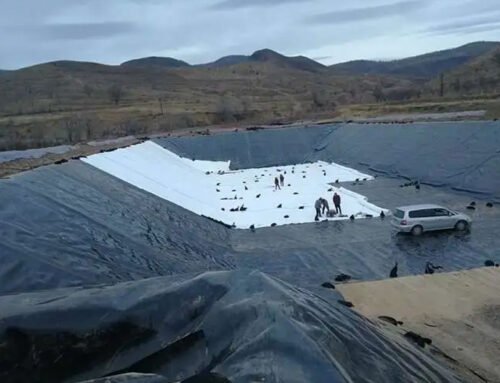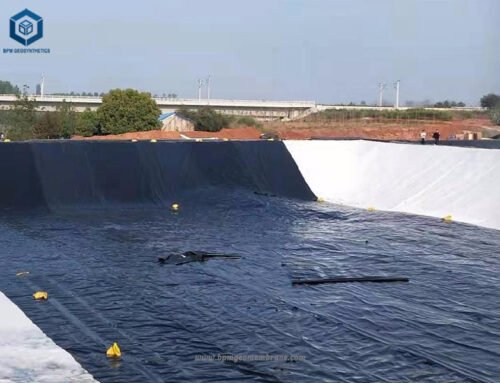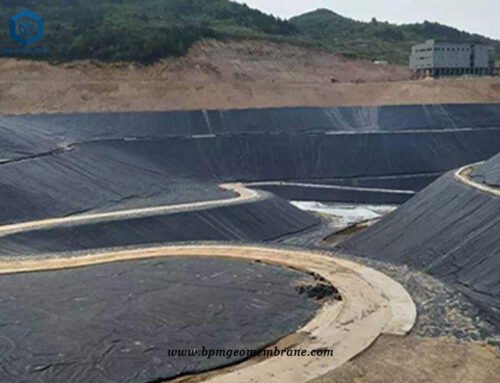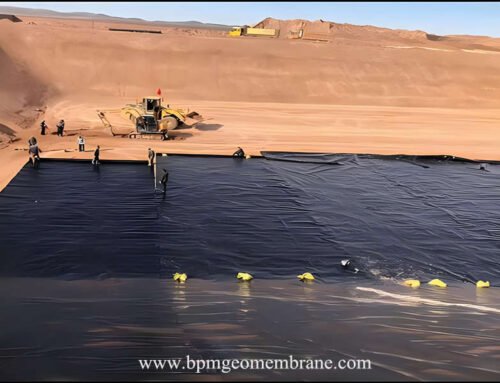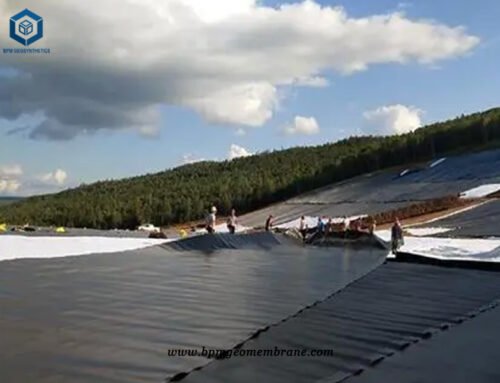High Density polypropylene geomembrane, also known as HDPE geomembrane liner, is the impermeable geotechnical engineering material which is widely used for landfill projects, solid waste containment, mining and water containment applications. BPM is the trusted geomembrane manufacturer and supplier, we offer complete line of smooth geomembrane, textured geomembrane at great price.
1. What Is Polypropylene Geomembrane?
1.1 Introduction to Polypropylene Geomembranes
Polypropylene (PP) geomembranes are synthetic liners widely used in geotechnical and environmental engineering for fluid containment. Made from thermoplastic polymers, they provide impermeable barriers in applications such as ponds, lagoons, and industrial containment systems. PP geomembranes are valued for their flexibility, elongation, and resistance to cold temperatures, making them suitable for harsh environments. BPM offers high-quality PP geomembranes with excellent UV stability and chemical resistance, ensuring long-term durability. Available in 30 and 40 mil thicknesses, these liners are ideal for projects requiring reliable fluid control.
1.2 Key Benefits of Polypropylene Geomembranes
PP geomembranes offer superior flexibility and elongation, allowing easy installation around complex structures. They perform exceptionally well in cold climates, with successful installations recorded at -50°C (-58°F). Their long-term UV stability prevents degradation from sunlight exposure, while advanced chemical resistance ensures durability in aggressive environments. BPM’s PP geomembranes also meet NSF/ANSI Standard 61 for drinking water safety, making them suitable for potable water applications. Additionally, their resistance to environmental stress cracking enhances longevity, even under high temperatures and chemical exposure.
1.3 Applications of Polypropylene Geomembranes
PP geomembranes are ideal for lining lagoons, ponds, and impoundments, providing secure containment for water, wastewater, and industrial liquids. Their flexibility allows for easy fabrication, making them suitable for floating covers and complex geometries. They are commonly used in mining, agriculture, and wastewater treatment due to their chemical resistance and durability. BPM’s PP geomembranes, available in large panels up to 33,000 square feet, minimize seams and improve installation efficiency. These liners are a reliable choice for projects requiring long-term fluid barrier solutions.
1.4 Why Choose BPM Polypropylene Geomembranes?
BPM’s PP geomembranes combine high performance with ease of installation, making them a preferred choice for engineers and contractors. Their exceptional cold-temperature resistance allows for installation in extreme climates, while UV stability ensures long-term outdoor use. With NSF/ANSI 61 certification available, they meet strict drinking water safety standards. Available in 30 and 40 mil thicknesses, BPM’s geomembranes provide optimal strength and durability for various containment applications. Whether for industrial, agricultural, or environmental projects, BPM delivers reliable, high-quality polypropylene geomembrane solutions.
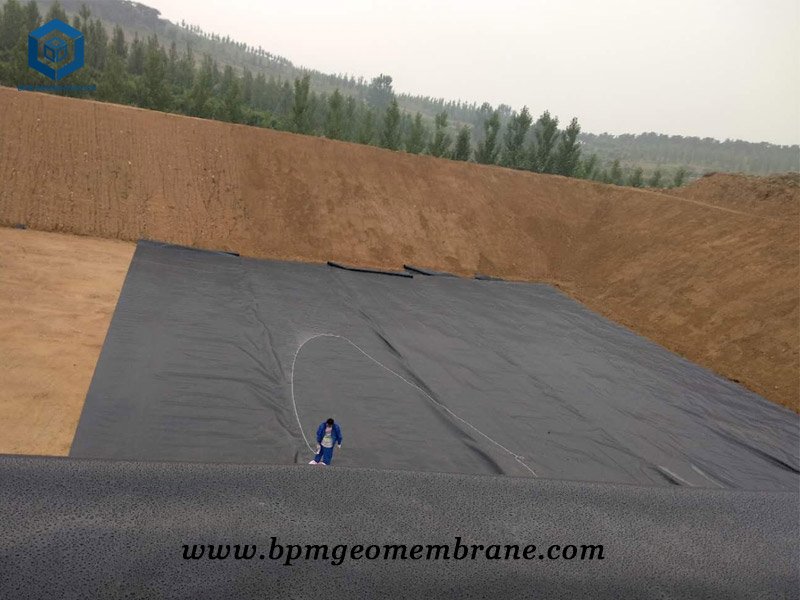


2. What Is The Raw Material for Geomembrane?
2.1 Raw Materials for Polyethylene Geomembranes
Manufacturers use virgin polyethylene resins as the primary raw material for producing geomembranes. These resins come from petroleum or natural gas through polymerization, ensuring high purity and consistent quality. Virgin polyethylene provides essential properties such as durability, flexibility, and impermeability, making it ideal for containment applications. Additionally, manufacturers incorporate carbon black as a key additive during production. This finely divided elemental carbon significantly enhances UV resistance, protecting the geomembrane from sunlight degradation.
By carefully selecting and blending these materials, manufacturers create geomembranes that perform reliably in demanding environments. The combination of virgin polyethylene and carbon black ensures long-term stability, making these liners suitable for landfills, mining, and water containment projects.
2.2 Benefits of High-Quality Raw Materials
Using virgin polyethylene resins guarantees superior strength and chemical resistance in geomembranes. Since these resins are free from recycled content, they maintain consistent performance over time. Furthermore, carbon black plays a crucial role in extending the geomembrane’s lifespan by preventing UV-induced breakdown.
Manufacturers optimize these materials to meet industry standards, ensuring geomembranes withstand harsh conditions. As a result, engineers and contractors can rely on these liners for critical applications such as environmental protection and fluid containment. The careful selection of raw materials ultimately leads to more durable, high-performance geomembranes.
3. What Is the Difference Between PVC And HDPE Geomembrane?
The main difference between PVS geomembrane and HDPE lies in their material composition and physical properties. PVC geomembranes are flexible and relatively easy to handle, while HDPE Geomembranes is tough and non-flexible.
3.1 Material Composition
Geomembrane is a broad term that refers to a category of synthetic liners used in geotechnical and environmental applications. It encompasses various materials such as PVC, HDPE (High-Density Polyethylene), and other types of polymers. HDPE, on the other hand, specifically refers to a type of geomembrane made from high-density polyethylene resin.
3.2 Flexibility
Geomembranes are known for their flexibility and relative ease of handling. They can conform to irregular surfaces and are often used in applications where flexibility is required, such as lining ponds or creating flexible barriers. HDPE geomembranes, on the other hand, are tough and non-flexible. They are typically used in applications where strength and puncture resistance are important, such as landfill liners or containment systems.
3.3 Physical Properties
PVC geomembranes offer advantages such as high flexibility, elongation, and ease of fabrication. They are also resistant to UV radiation and have good chemical resistance. HDPE geomembranes, on the other hand, are known for their toughness, high tensile strength, and resistance to puncture and tearing. They have excellent resistance to chemicals, UV radiation, and environmental stress cracking.
3.4 Applications
Due to their flexibility, PVC geomembranes are commonly used in applications such as pond and lagoon liners, decorative water features, and flexible containment systems. HDPE geomembranes, with their superior strength and durability, are often used in applications such as landfill liners, mining tailings ponds, and industrial containment.
HDPE is a specific type of geomembrane made from high-density polyethylene, geomembrane is a broader term that encompasses various materials, including PVC, HDPE, and others. The choice between PVC and HDPE geomembranes depends on the specific requirements and conditions of the application.
4. Why Chose High Density Polypropylene Geomembrane for Landfill Project in Ghana
4.1 Initial Customer Inquiry and Requirements
A Ghana-based customer found our company through Google search and contacted us regarding their landfill project needs. They specifically requested 1.5mm HDPE geomembrane with key performance requirements including impermeability, water resistance, and minimum rupture strength of 40KN/M. Importantly, they needed the quotation submitted by 10 p.m. the same day to meet their project timeline.
Recognizing the urgency, our sales team immediately sprang into action. We quickly prepared detailed product specifications, manufacturing process videos, and relevant test reports to demonstrate our product’s compliance with their technical requirements. This comprehensive package allowed the customer to thoroughly evaluate our solution before making any commitments.
4.2 Sample Delivery and Price Negotiation
To further build trust and confidence, we expedited free sample shipments the very next day. The samples perfectly matched their required specifications, clearly demonstrating our product quality and technical capabilities. Meanwhile, our pricing team worked diligently to develop a competitive quote that aligned with both market standards and the customer’s budget constraints.
Through transparent communication and flexible negotiation, we addressed all of the customer’s concerns regarding product quality, delivery timelines, and payment terms. Our proactive approach in providing samples and competitive pricing helped establish credibility and moved the discussion forward productively.
4.3 Successful Contract Signing and Partnership
Within just one week of initial contact, we successfully finalized the contract – a testament to our efficient processes and customer-focused approach. The customer expressed complete satisfaction with our responsiveness, product quality, and business terms.
This successful transaction marks the beginning of a promising partnership for the Ghana landfill project. It showcases our ability to understand customer needs, deliver prompt solutions, and build long-term relationships through reliable products and professional service. Our team remains committed to maintaining this high standard for all international projects.
5. Specifications of Polypropylene Geomembrane for Landfill in Ghana
- Total quantity – 56,000m2
- Textured Geomembrane thickness – 1.5mm
- Each roll size – 7m*100m
6. About BPM
BPM is the professional geosynthetics manufacturer and exporter. Our main innovative, high quality geosynthetic products include geomembranes, geotextiles, geocells, geosynthetic clay liners (GCLs), drainage boards, geogrids, etc. BPM brand geosynthetic product had been certificated by the ISO9001, ISO14001,OHSAS18001 Soncap, SASO and BV certificates and passed the test of SGS and Intertek, etc. Our geosynthetic products have exported to over 36 countries.
BPM Geomembrane is also providing professional geomembrane design and installation service. OEM and ODM are also available. If you have any questions or inquiries, please contact us, we will reply as soon as possible.

